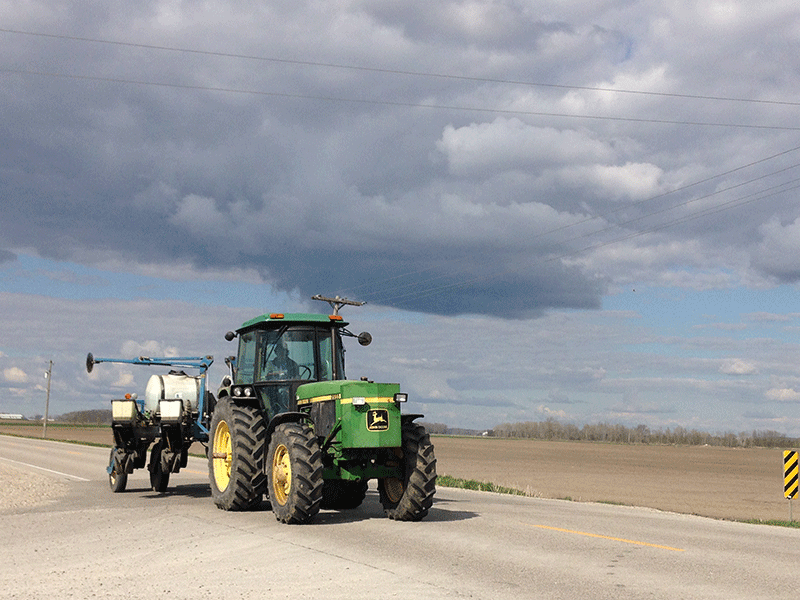Rural rejuvenation
SUPPORTING RURAL COMMUNITIES WITH AN EYE TO GROWTH

WHEN THE FEDERAL budget of 2016 was announced in late March, the focus was on infrastructure spending — a lot of so-called ‘unsexy’ projects that would be funded in order to stimulate the economy. There were many stakeholders who commented on the budget, from mayors to manufacturing associations, to Grain Farmers of Ontario. Barry Senft, Grain Farmers of Ontario CEO, publicly stressed a need for improvements to rural road infrastructure, upgrades that will help growers get their harvest to market.
But are federal politicians truly showing an understanding of rural challenges? Just how important are rural and agricultural concerns to politicians at all levels, and to the general public? What are the factors and policies that will affect farmers a little or a lot over the next few years and next few decades?
Wayne Caldwell has been interested in these questions since his youth. “I was born and raised on a farm, and I’ve always had a real interest in rural issues,” says the professor of rural planning in the School of Environmental Design and Rural Development and interim dean of the Ontario Agricultural College, University of Guelph. Seeing the changes in his community over time was fascinating for Caldwell — all the forces at work, both positive and negative.
CHANGING DEMOGRAPHICS
Demographics has always been among the strongest of the forces affecting rural Ontario. In 1851, the vast majority of the population, 86 per cent, lived in rural areas. In 2011, 86 per cent lived in urban areas. Farmer populations have also shrunk and there are now more rural non-farm residents than ever before.
Total provincial farm area decreased by almost nine per cent between 1996 and 2011 and the number of farms decreased as well — there were 90,000 farms in 1975 compared to about 46,000 in 2011. At the same time, average farm size has risen from about 110 acres in 1920 to 240 acres in 2011, and most livestock operations have become more intensified.
In Ontario, the value of farmland has increased at a staggering rate, rising nearly 2000 per cent since 1973. “Statistics Canada reported in 2013 that the average value of an Ontario farm acre was $8,400,” says Caldwell. “In some parts of the province farmland now sells for $25,000 per acre or more, both within and outside the ‘urban shadow’. This makes the prospect of selling farmland quite attractive.”
On a global scale, some factors will affect Ontario farmers more than others. World population growth will continue. Global economic power will increasingly shift to emerging economies such as China, India, and Brazil, Caldwell observes, with ever-growing foreign competition for grains and food products. “On the other hand, certain economies will stagnate because of rising energy prices and availability,” he notes. “We will increasingly reach for technological solutions, but there’s no guarantee of success.”
RESPECTING RURAL
Services of all kinds, from education to health care, have been stretched for quite a while in rural areas, and that will likely continue. At the same time, Caldwell notes that the number of non-farm job opportunities varies across the province, and both labour shortages and skills shortages have grown. In general, incomes will continue to be lower in rural areas and in some areas farmland will continue to be lost to urban encroachment. Urban-rural conflicts over resources are going to be more common.
Caldwell is measuring farmland conversion and has found some surprising information. “The municipal decisions to change farmland designation and permit development were in many cases made a long time ago, but the land continues to be farmed for some years before development occurs,” he says. “People get upset when they see development starting, and wonder how a recent approval could have been snuck through without notice, but it may have been approved years ago.”
Caldwell is doing a number of other research projects, including a close look at local food systems in Northern Ontario, and how government policies can support agriculture.
Of all of the issues affecting Ontario farmers, Caldwell considers shrinking populations to be one of the most under-rated. “Birth rates have fallen so much and rural Ontario’s population is aging,” he notes. “The reason Canada’s overall job and net population is growing is immigration, and it’s important that rural, northern, and remote communities do much more to attract immigrants,” he says.
“While there are costs to providing the supports that attract immigrants, it’s an investment in the future. And once population levels in rural areas steady off or begin to grow, there is more leverage to call for better infrastructure and roads, community supports, and more people to work on and take over farms. The smaller farms in particular in this province need more supports, such as access to processing facilities.” Caldwell urges the leaders in rural areas to follow the lead of Huron County, which has an official immigration attraction strategy.
He points to climate change as being another large factor that will affect Ontario farmers, with increased crop productivity probable.
“We may have big opportunities in the future because of decreased productivity (due to the effects of climate change) in other parts of the world,” says Caldwell. “In addition, Ontario farmers have more diverse agricultural opportunities than ever before, and interest in locally-grown food has never been higher. Opportunities for alternative energy projects are also good. With a focus on sustainability, creativity, community engagement, and partnerships, farmers and other rural citizens can continue to have a good quality of life. But it won’t come without building local economies and the supporting structures, with a strong focus on attracting immigrants.” •






















